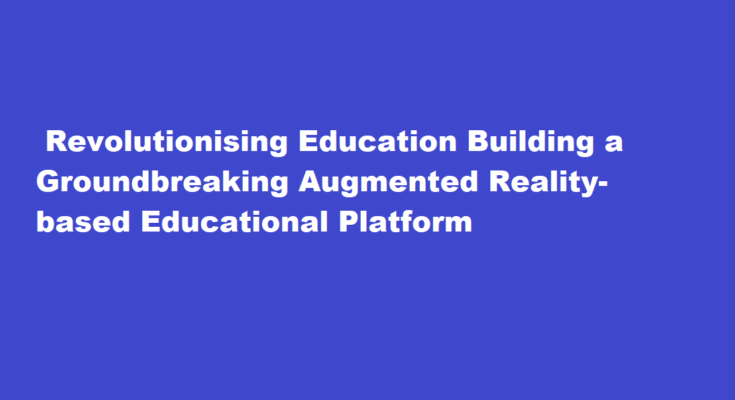Introduction
In today’s rapidly evolving digital landscape, traditional educational methods are no longer sufficient to cater to the diverse learning needs of students. Augmented Reality (AR) technology has emerged as a powerful tool that can transform the way we teach and learn, offering immersive, interactive, and engaging experiences. Building a groundbreaking AR-based educational platform can revolutionise the educational paradigm, providing students with a more personalized and effective learning journey. This article explores the key steps and considerations involved in developing such an innovative platform.
Vision and Objectives
The first step in creating a groundbreaking AR-based educational platform is to define a clear vision and set specific objectives. Understand the core challenges faced by traditional education systems and envision how AR technology can address them. Determine the target audience, such as students of different age groups or specific subjects, and set measurable goals for their learning outcomes.
Research and Collaboration
Comprehensive research is vital to identify existing AR-based educational solutions, technological possibilities, and potential competitors. Collaborate with educators, subject matter experts, and technology specialists to gather insights into the most effective learning methodologies and content delivery approaches.
Content Creation and Curation
AR technology allows for the integration of rich multimedia elements into the learning process. Develop high-quality content that aligns with the curriculum, leveraging AR’s interactive capabilities. Content can include 3D models, simulations, virtual experiments, and immersive historical reconstructions, enhancing students’ understanding and retention.
User-friendly Interface
An intuitive and user-friendly interface is essential for the success of an educational AR platform. Ensure that the platform is accessible across different devices, such as smartphones, tablets, and AR headsets, to maximize its reach. Consider the needs of both teachers and students while designing the interface and navigation.
Gamification and Rewards
Integrating gamification elements can significantly enhance student engagement. By incorporating interactive challenges, quizzes, and rewards, educators can motivate students to actively participate in their learning journey. Leaderboards and achievements can create a sense of healthy competition, encouraging students to excel.
Data Analytics and Personalization
Collecting data on student interactions within the AR platform can provide valuable insights into their learning patterns and preferences. Utilise this data to personalize the learning experience for each student, offering content and activities tailored to their strengths, weaknesses, and learning pace.
Teacher Training and Support
AR-based education requires a paradigm shift in teaching methods. Provide comprehensive training and support to educators to effectively use the platform in the classroom. Encourage continuous professional development to keep them updated with the latest AR technologies and pedagogical techniques.
Collaboration and Social Learning
Promote collaborative learning experiences by enabling students to interact with their peers in an AR environment. Virtual group projects, online discussions, and shared learning spaces foster social learning and enhance critical thinking and problem-solving skills.
Integration with Curriculum and Accreditation
For widespread adoption, the AR platform must seamlessly integrate with existing curricula and educational standards. Collaboration with educational authorities and institutions can facilitate the accreditation and recognition of the platform’s efficacy.
Accessibility and Inclusivity
Ensure the AR-based educational platform is designed with accessibility and inclusivity in mind. Consider students with disabilities and provide alternative modes of interaction to accommodate their needs. Subtitles, audio descriptions, and adaptive features can enhance the learning experience for all students.
FREQUENTLY ASKED QUESTIONS
How do you create augmented reality for education?
The most popular application for augmented reality in education is the use of AR apps directly in the classroom. In this case, they can help the teacher explain a subject, provide a visual representation of the material, and help students test out their knowledge in practice.
What is the future of AR in education?
It can enhance the learning process and make it more enjoyable, fun, and efficient. It can motivate students to learn, especially if augmented reality is incorporated. Furthermore, it can introduce new teaching methods and enhance classroom interaction.
Conclusion
Developing a groundbreaking, augmented reality-based educational platform requires a fusion of technological innovation and pedagogical expertise. By leveraging the immersive and interactive capabilities of AR, we can transcend the limitations of traditional education and create a more personalized and engaging learning experience. Embracing this revolutionary technology has the potential to shape a new era of education, empowering students to become active learners and critical thinkers in an ever-changing world. With dedication, collaboration, and an unwavering commitment to excellence, we can transform the landscape of education and pave the way for a brighter future.
Read Also : Creating a Thriving Vertical Garden A Blueprint for Sustainable Urban Green Spaces



